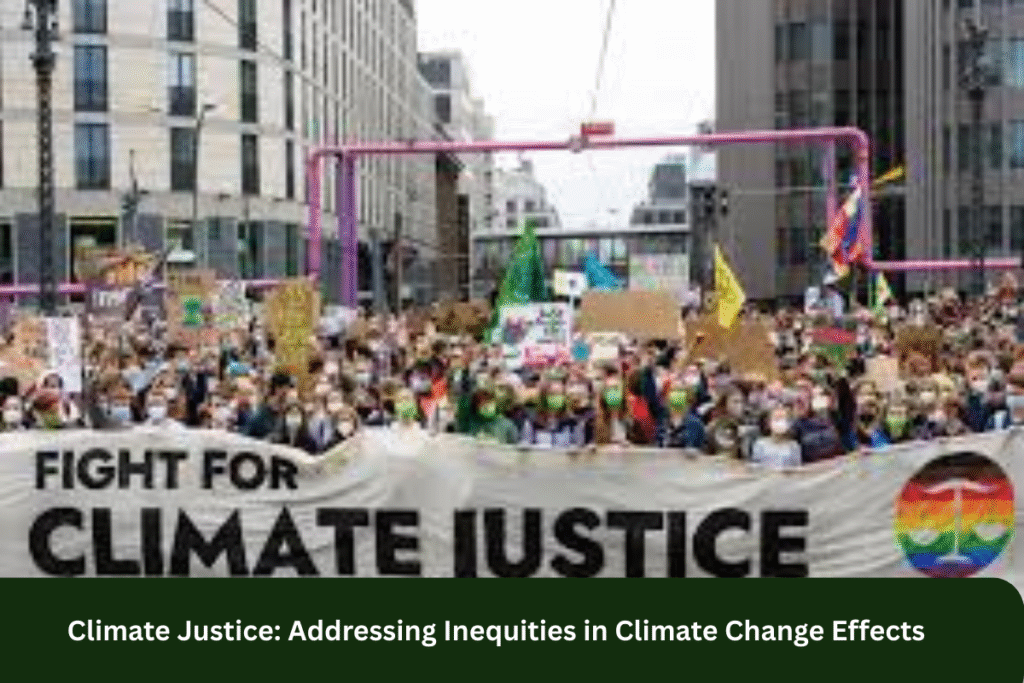
As the global community faces the escalating crisis of climate change, one key aspect that often goes unnoticed is the issue of climate justice. Climate change does not affect everyone equally. Vulnerable communities, especially those in developing nations, marginalized populations, and indigenous groups, bear the brunt of its impacts despite contributing the least to greenhouse gas emissions. This inequity raises serious ethical concerns and underscores the need for a more inclusive approach to climate action. In this article, we will explore the concept of climate justice, its significance, and how we can address the inequities in the effects of climate change.
1. What is Climate Justice?
Climate justice is the recognition that climate change affects people differently, with the most vulnerable communities experiencing disproportionate harm. It is rooted in the principle that those who contribute least to the problem of climate change (in terms of emissions) are often the most impacted by its consequences.
Climate justice calls for:
- Equitable access to resources: Ensuring that everyone, especially marginalized groups, has the resources and opportunities to adapt to climate change and mitigate its effects.
- Acknowledging historical responsibility: Recognizing that industrialized nations, which have historically contributed the most to emissions, have a responsibility to support developing nations in their climate efforts.
- Human rights: Addressing the social, economic, and political rights of those impacted by climate change, including the right to life, health, and sustainable development.
In essence, climate justice goes beyond environmental protection—it also addresses the social, economic, and ethical dimensions of climate change, advocating for fairness and equity in climate action.
2. The Unequal Effects of Climate Change
Climate change exacerbates existing inequalities, with certain populations facing much greater challenges in coping with its impacts. Below are some of the key ways in which climate change disproportionately affects vulnerable groups:
a. Vulnerable Communities in Developing Countries
Many of the countries most vulnerable to climate change are also those least responsible for the problem. Sub-Saharan Africa, parts of Asia, and small island nations are particularly at risk from extreme weather events, rising sea levels, and changing rainfall patterns. These regions often lack the resources, infrastructure, and technology to adapt to these changes.
- Food Security: Climate change disrupts agriculture, leading to crop failures and food shortages, disproportionately affecting communities that depend on agriculture for survival.
- Water Scarcity: Many developing countries face water scarcity due to changing weather patterns, making access to clean water more difficult for vulnerable populations.
- Displacement: Rising sea levels and extreme weather events are forcing communities in coastal and low-lying areas to migrate, often leading to climate-induced displacement.
b. Indigenous Communities
Indigenous communities often live in areas that are directly dependent on natural resources, such as forests, rivers, and coastal ecosystems. These communities are deeply connected to the land, and climate change threatens their way of life.
- Cultural Displacement: Indigenous peoples are often the first to experience the loss of land and cultural heritage due to climate change. The disruption of their traditional livelihoods—such as farming, fishing, and hunting—puts their culture and traditions at risk.
- Limited Resources for Adaptation: Indigenous groups frequently lack access to the financial and technical resources necessary to adapt to climate change, leaving them more vulnerable to its effects.
c. Marginalized Groups within Wealthy Nations
In wealthy countries, marginalized communities—including low-income people, people of color, and those with limited access to healthcare—are more vulnerable to climate change impacts.
- Health Risks: These communities often live in areas more susceptible to climate-related health risks, such as heatwaves, air pollution, and infectious diseases.
- Inequitable Access to Resources: Lower-income populations may lack the resources to adapt to climate change, such as living in flood-prone areas or lacking access to cooling systems during heatwaves.
3. Climate Justice and International Responsibility
Addressing climate justice requires recognizing the responsibilities of both industrialized and developing nations in contributing to climate change:
a. Historical Responsibility of Developed Nations
Developed nations have historically emitted the majority of global greenhouse gases, contributing significantly to the climate crisis. Many of these countries are also the ones with the most resources to address and mitigate the effects of climate change. Climate justice calls for these nations to take the lead in reducing emissions, providing financial support, and assisting vulnerable countries in adapting to the impacts of climate change.
- Financial Support: Developed nations are encouraged to contribute to global climate funds, such as the Green Climate Fund, to assist developing countries in financing climate adaptation and mitigation projects.
- Technology Transfer: Wealthier countries should provide access to clean technologies and knowledge to help developing nations transition to low-carbon economies.
b. Equitable Global Cooperation
While developed nations have a historical responsibility, climate justice also calls for inclusive cooperation where the voices and needs of vulnerable communities are heard in international negotiations. This means ensuring that climate policies and solutions take into account the perspectives of those most affected by climate change.
4. How Can We Address Climate Justice?
Addressing climate justice requires both global action and local solutions. Here are some ways to work toward a fair and just transition to a low-carbon future:
a. Inclusive Policy Development
Governments and international organizations must include marginalized communities in the development of climate policies and solutions. This means:
- Consulting vulnerable groups to ensure that their needs and perspectives are integrated into climate action plans.
- Ensuring equitable access to resources and climate adaptation measures for all communities.
b. Climate Finance for Vulnerable Countries
Developed nations must fulfill their financial commitments to climate change mitigation and adaptation efforts in developing countries. This includes providing funding for:
- Adaptation projects to help vulnerable communities withstand the impacts of climate change, such as building resilient infrastructure or improving agricultural techniques.
- Mitigation projects to reduce emissions and transition to renewable energy sources, ensuring a sustainable future for all nations.
c. Empowering Indigenous and Local Communities
Supporting indigenous and local communities in climate change adaptation efforts is crucial. This includes:
- Protecting land rights: Ensuring that indigenous communities have the legal protection to safeguard their land and resources.
- Supporting traditional knowledge: Incorporating indigenous knowledge of sustainable land and resource management into modern climate strategies.
d. Promoting Sustainable Consumption and Production
Climate justice also involves changing consumption patterns in wealthy nations. Reducing consumption of resources and promoting sustainable production methods can help reduce the global carbon footprint and address inequities by not further taxing the environment and vulnerable communities.
5. FAQs
1. What is climate justice?
2. How does climate change affect vulnerable communities?
3. What role do developed nations play in climate justice?
4. How can we address climate justice?
6. Conclusion
Climate justice is a critical component of the global fight against climate change. It calls for a fair and inclusive approach to addressing the impacts of climate change, particularly for the most vulnerable communities. By recognizing the inequities that exist in climate change effects and working toward equitable solutions, we can ensure a sustainable and just future for all. Climate justice requires global cooperation, financial support, and a commitment to human rights, ensuring that no one is left behind in the transition to a low-carbon economy.
ChatGPT can make mistakes. Check important info. See Cooki
